 |
|
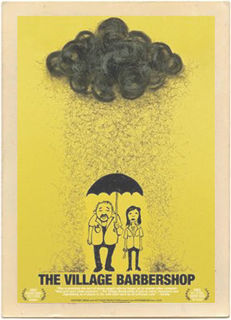 The Village Barbershop The Village Barbershop2008. Monterey Media, Color, Aspect Ratio 2.35 : 1, 99 minutes, Rated R Release Date: February 29, 2008 The Village Barbershop is available at Amazon.com on DVD. Movie Synopsis: This is the humorous, sweet story of a man who has lost his way through the pain and loss of growing older, and a determined young woman looking to find hers: two unlikely people offered a second chance in one unlikely place. The Village Barbershop. ~Aimee Cast: John Ratzenberger, Shelly Cole, Cindy Pickett, George McRae, Daron Jennings, Josh Hutchinson, Cory DuVal, Amos Glick Director: Chris J. Ford Thoughts on the Movie: Of course, everyone knows John Ratzenberger. I was never a fan of Cheers, or his character in that sitcom, so I had no idea going in what this movie might be. But the title was really intriguing... is it possible? Could this be one of those little films that proves to be an absolute gem? Yes indeed! This is a “quiet little fave,” as I like to say. Alongside The Station Agent and Off The Map, this has become one of my all-time favorites. It’s a slice of life, a character study, a glimpse into the development of an unexpected friendship; the kind of friendship that changes... dare I say, perhaps even saves a life (or two). And it sneaks up and grabs you. The first effort of Reno native, Chris Ford, The Village Barbershop is, I hope, the beginning of a long and fruitful career for this filmmaker. I’m certainly looking forward to his next project! ~Aimee 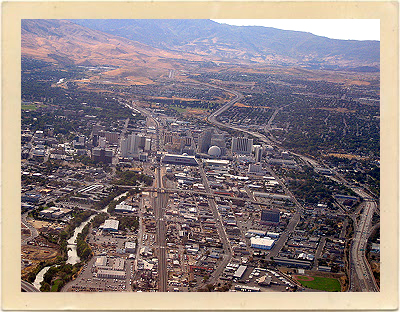 Location Site: Location Site:Reno, Nevada (see Map) Many scenes in The Village Barbershop were shot in Reno, but some scenes were shot in Napa, California. The Casino scenes, the jail, the strip club, and all significant exteriors were shot in Reno. Right: Modern-day Reno, Nevada, as seen from above. About Reno, Nevada: Reno, Nevada (population 220,598; elevation 4,405 feet; 39° 31’ 38” N, 119° 49’ 19” W) is located near the eastern border of the state on 1-80. It is approximately 20 miles north of Carson City, Nevada. Reno sits in a high desert valley at the foot of the Sierra Nevada. It is famous for its casinos, and is the birthplace of the gaming corporation Harrah’s Entertainment. City residents are called “Renoites.” As early as the 1850s, a few pioneers settled in the Truckee Meadows, a relatively fertile valley through which the Truckee River made its way from Lake Tahoe to Pyramid Lake. In addition to subsistence farming, these early residents could pick up a bit of business from travelers along the California Trail, which followed the Truckee westward, before branching off towards Donner Lake, where the formidable obstacle of the Sierras began. Gold was discovered in the vicinity of Virginia City in 1850, and a modest mining community developed, but the discovery of silver in 1859, led to one of the greatest mining bonanzas of all time, as the Comstock Lode spewed forth treasure. The Comstock's closest connection to the outside world lay in the Truckee Meadows. To provide the necessary connection between Virginia City and the California Trail, Charles W. Fuller built a log toll bridge across the Truckee River. A small community that would service travelers soon grew up near the bridge. After two years, Fuller sold the bridge to Myron C. Lake, who continued to develop the community with the addition of a grist mill, kiln, and livery stable. He renamed it Lake’s Crossing. In 1864, Washoe County was consolidated with Roop County and Lake’s Crossing became the largest town in the county. Lake had earned himself the title “founder of Reno.” 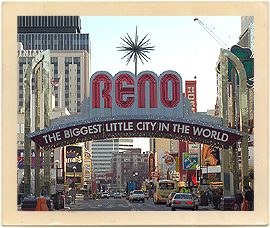 The extension of the Virginia and Truckee Railroad to Reno in 1872, provided another big boost to the new city’s economy. At first citizens viewed the changes as an omen, however in the following decades, Reno continued to grow and prosper as a business and agricultural center and would become the principal settlement on the transcontinental railroad between Sacramento and Salt Lake City. As the mining boom waned early in the 20th century, Nevada’s centers of political and business activity shifted to the non-mining communities, especially Reno and Las Vegas, and today the former mining metropolises stand as little more than ghost towns. Despite this, Nevada is still the third-largest gold producer in the world, after South Africa and Australia. The extension of the Virginia and Truckee Railroad to Reno in 1872, provided another big boost to the new city’s economy. At first citizens viewed the changes as an omen, however in the following decades, Reno continued to grow and prosper as a business and agricultural center and would become the principal settlement on the transcontinental railroad between Sacramento and Salt Lake City. As the mining boom waned early in the 20th century, Nevada’s centers of political and business activity shifted to the non-mining communities, especially Reno and Las Vegas, and today the former mining metropolises stand as little more than ghost towns. Despite this, Nevada is still the third-largest gold producer in the world, after South Africa and Australia.Right: The famous “Reno Arch” has welcomed millions of people to the “Biggest Little City in the World.” The famous “Reno Arch” was erected on Virginia Street in 1926, and to promote the upcoming Transcontinental Highways Exposition of 1927, the arch included the words “Nevada’s Transcontinental Highways Exposition.” After the exposition, the Reno City Council decided to keep the arch as a permanent downtown gateway, and Mayor E.E. Roberts asked the citizens of Reno to suggest a slogan for the arch. No acceptable slogan was received until a $100 prize was offered, and G.A. Burns of Sacramento was declared the winner on March 14, 1929, with “Reno: The Biggest Little City in the World.” Nevada’s legalization of casino gambling in 1931, and the passage of liberal divorce laws, created another boom for Reno. In Ayn Rand’s novel “The Fountainhead,” published in 1943, the New-York-based female protagonist tells a friend, “I am going to Reno,” which is taken as a different way of saying “I am going to divorce my husband.” The divorce business eventually died as the other states fell in line by passing their own laws, easing the requirements for divorce, but gambling continued as a major Reno industry. 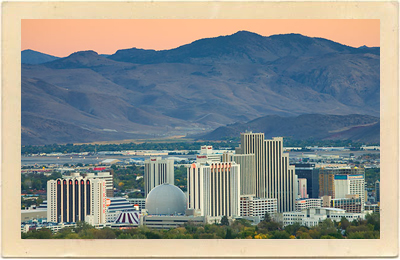 Before the late 1950s, Reno was the gambling capital of the United States, but in the last twenty years Las Vegas’ rapid growth, American Airlines’ 2000 buyout of Reno Air, and the growth of Indian gaming in California have somewhat reduced its business. Older casinos were either torn down (Mapes Hotel, Fitzgerald’s Nevada Club, Primadonna, Horseshoe Club, Harold’s Club, and the Palace Club) and smaller casinos like the Comstock, Sundowner, Golden Phoenix, Kings Inn, Money Tree, Virginian, and Riverboat closed. The closure of many downtown casinos has sparked a movement to turn them into condominiums. Out-of-state developers have purchased the Comstock and the Sundowner, amongst others, in hopes of turning them into upscale condos. In addition to converting old properties, these developers are building new structures on formerly vacant lots. The Comstock was redeveloped and is now home to The Residences at Riverwalk Towers. Before the late 1950s, Reno was the gambling capital of the United States, but in the last twenty years Las Vegas’ rapid growth, American Airlines’ 2000 buyout of Reno Air, and the growth of Indian gaming in California have somewhat reduced its business. Older casinos were either torn down (Mapes Hotel, Fitzgerald’s Nevada Club, Primadonna, Horseshoe Club, Harold’s Club, and the Palace Club) and smaller casinos like the Comstock, Sundowner, Golden Phoenix, Kings Inn, Money Tree, Virginian, and Riverboat closed. The closure of many downtown casinos has sparked a movement to turn them into condominiums. Out-of-state developers have purchased the Comstock and the Sundowner, amongst others, in hopes of turning them into upscale condos. In addition to converting old properties, these developers are building new structures on formerly vacant lots. The Comstock was redeveloped and is now home to The Residences at Riverwalk Towers.Right: Today, the Reno cityscape looks strangely futuristic, laid out in front of Nevada’s majestic mountains. In an effort to bring more tourism to the area, Reno holds several events throughout the year, most of which have been extremely successful. They include Hot August Nights (a classic car convention), Street Vibrations (a motorcycle fan gathering and rally), The Great Reno Balloon Race, the Best in the West Nugget Rib Cook-off (held in Sparks), a Cinco de Mayo celebration, bowling tournaments (held in the National Bowling Stadium), and the Reno Air Races. Local Attractions: The El Cortez Hotel. Built in 1931, this hotel is historically important due to its Art Deco style. It was also the tallest structure in Reno at the time it was built. The hotel experienced such extensive use early on, that an addition was built just a few years after its construction. The hotel included the Orchid Room, a swanky bar and a popular restaurant called the Tracedero Room. These rooms were elegantly appointed with stylish Art Deco ornamentation. The El Cortez was a high-class hotel, garnering an astounding $6 per night, compared to the prevailing room rate of $2.50 per night. The El Cortez was built in anticipation of increased divorce traffic, after Reno’s divorce law was liberalized in 1931. The residency period for those seeking a divorce in Reno was reduced from three months to six weeks, to boost the already lucrative divorce trade. El Cortez was one of several temporary residential complexes constructed during this time. The hotel is considered a local landmark and is on the Register of Historic Places. 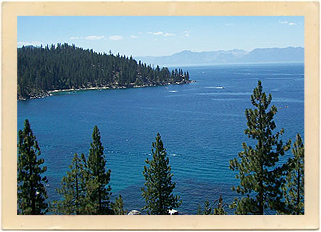 Lake Tahoe Lake TahoeLake Tahoe is a large freshwater lake in the Sierra Nevada range of the United States. At a surface elevation of 6,225 feet, it is located along the border between California and Nevada, west of Carson City, Nevada. Lake Tahoe is the largest alpine lake in North America. The lake was formed about 2 million years ago and is a part of the Lake Tahoe Basin, with the modern lake being shaped during the ice ages. It is known for the clarity of its water and the panorama of surrounding mountains on all sides. The area surrounding the lake is also referred to as Lake Tahoe. Right: Lake Tahoe, Nevada, is one of America’s most beautiful travel destinations. Lake Tahoe is a major tourist attraction in both Nevada and California. It is home to a number of ski resorts, summer outdoor recreation, and tourist attractions. Snow and skiing are a significant part of the area's economy and reputation. The Nevada side also includes large casinos. Highways provide year-round access from Reno, Carson City and Sacramento. The primary routes to Lake Tahoe are on I-80 via Truckee, US 50, and NV 431 via Reno. Most of the highways accessing and encircling Lake Tahoe are paved two-lane mountain roads. US 50 is a four-lane highway passing south of the lake and along part of the eastern shore. CA 89 follows the western shore of the lake through the picturesque wilderness and connects camping, fishing and hiking locations such as those at Emerald Bay State Park. CA 28 completes the circuit from Tahoe City around the northern shore to communities such as Kings Beach, Crystal Bay, and into Incline Village, Nevada where the road becomes NV 28. 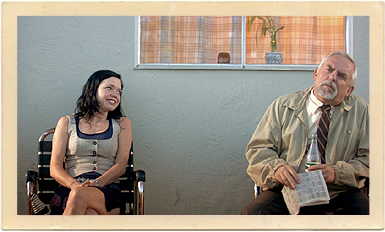 Lodging & Dining: Lodging & Dining:Wildflower Village Bed & Breakfast. 4305 W. Fourth Street, Reno, Nevada Wildflower Village offers artist studios, a hostel, apartments, wedding chapel, gift shop, and an espresso bar. Located on six-plus acres in a country setting, just 2 miles from downtown Reno. Dickey’s Barbecue Pit. 395 E. Plumb Lane, Reno, Nevada Try the pulled pork sandwich, giant dill pickles, and cheesy potato casserole. Messy meals, but fairly priced with generous portions. If you are a carboholic, go for their hot-buttered rolls: airy poofs of warm, melt-in-your-mouth delights. Right: Shelly Cole and John Ratzenberger in a scene from “The Village Barbershop.” Filming Info: Due to budget limitations, although it looks like film, The Village Barbershop was shot on a relatively inexpensive digital camera. 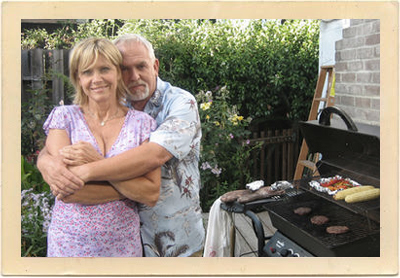 Awards: Awards:• The Village Barbershop won the Audience Award at Cinequest for Best Picture. • Shelly Cole won the Newport Beach Film Festival Award for Best Actress. Right: Cindy Pickett and John Ratzenberger share a hug on location during the making of the 2008 independent film, “The Village Barbershop.” Movie Trivia: • The Village Barbershop was the first feature film from writer and director Chris Ford. He wrote the original screenplay in 1997, while he was working in advertising in New York. • “I have two fetishes: sneakers and old fashioned barbershops. I do not know why.” Director, Chris Ford. • Amos Glick is a Bay Area actor, improviser, and clown, who spent many years performing with The San Francisco Mime Troupe and The Pickle Family Circus. • Director-screenriter Chris Ford grew up in Reno, and frequented the local barbershop as a kid and in his college years. He based his main character of The Village Barbershop on “the guy I always went to at the barbershop. He’s a super-genius old guy who knows everything about where I went to high school and college, and all my friends, and he keeps remembering it all the time. He’s a steel trap.” Character Quote: “I’ll start cuttin’ ladies’ hair in my own good time, thank you very much!” ~Art Leroldi (John Ratzenberger) |
|